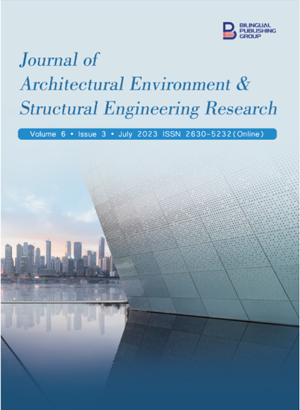-
379
-
230
-
191
-
190
-
178
Sustainability of Bridges: Risk Mitigation for Natural Hazards
DOI:
https://doi.org/10.30564/jaeser.v6i3.5807Abstract
Bridges serve as essential parts of transportation infrastructure, facilitating the movement of people and goods across rivers, valleys, and other obstacles. However, they are also susceptible to a wide range of natural hazards, including floods, earthquakes, and landslides, which can damage or even collapse these structures, leading to severe economic and human losses. A risk index has been developed to address this issue, which quantifies the likelihood and severity of natural hazards occurring in a specific location. The application of risk indices for natural hazards in bridge management involves a data collection process and mathematical modelling. The data collection process gathers information on bridges’ location, condition, and vulnerability, while mathematical modelling uses the data to assess the risk of natural hazards. Overall, risk indices provide a quantitative measure of the vulnerability of bridges to natural hazards and help to prioritize maintenance and repair activities. Mitigation measures are then evaluated and implemented based on the risk assessment results. By using this tool, the UBMS research group has developed an algorithm for risk assessment which will be essential in the decision-making process, specifically focused on enhancing Fund Optimization, Deterioration Modelling, and Risk Analysis. These developments effectively fulfill the primary objectives associated with addressing and mitigating hazards. This development also helps bridge managers understand the potential threats posed by natural hazards and allocate resources more efficiently to ensure the safety and longevity of critical transportation infrastructure.
Keywords:
Hazards; Risk index; Vulnerability; Mitigation measures; Decision-making process; Fund optimization; Deterioration modelling; Risk analysisReferences
[1] Asrani, N.P., Venkatasubramanian, C., Muthu, D., et al., 2018. Risk management — decision making using analytical hierarchy process. International Journal of Engineering & Technology. 7(3.12), 188. DOI: https://doi.org/10.14419/ijet.v7i3.12.15917
[2] Rahman, J., Billah, A.M., 2023. Development of performance-based fragility curves of coastal bridges subjected to extreme wave-induced loads. Journal of Bridge Engineering. 28(3), 04023005.
[3] Patel, K., 2013. A study on risk assessment and its management in India. American Journal of Civil Engineering. 1(2), 64-67.
[4] Pablo Jr, R.M., 2009. Risk assessment of highway bridges: A reliability-based approach. The Technology Interface Journal. 10(2), 165-172.
[5] Heldt, T., 2019. Enabling Better Bridge Management by Understanding Risk by Tim Heldt [Internet]. Available from: http://ipweaq.intersearch.com.au/ipweaqjspui/handle/1/5378
[6] Thompson, P.D., Western, J., Bye, P., et al., 2016. Assessing Risk for Bridge Management: Final Report [Internet]. Available from: https://onlinepubs.trb.org/Onlinepubs/nchrp/docs/NCHRP2007Task378FinalReport.pdf
[7] Kameshwar, S., Padgett, J.E., 2014. Multi-hazard risk assessment of highway bridges subjected to earthquake and hurricane hazards. Engineering Structures. 78, 154-166.
[8] Banerjee, S., Ganesh Prasad, G., 2013. Seismic risk assessment of reinforced concrete bridges in flood-prone regions. Structure and Infrastructure Engineering. 9(9), 952-968.
[9] Joshi, S., Thorat, A., Dehadray, H., et al., 2023. GABM tool for Risk Mitigation of Natural Hazards of Bridges [Internet]. Available from: https://constrofacilitator.com/gabm-tool-for-risk-mitigation-of-natural-hazards-of-bridges/
[10] Asprone, D., Jalayer, F., Prota, A., et al., 2010. Proposal of a probabilistic model for multi-hazard risk assessment of structures in seismic zones subjected to blast for the limit state of collapse. Structural Safety. 32(1), 25-34.
[11] Akintoye, A.S., MacLeod, M.J., 1997. Risk analysis and management in construction. International Journal of Project Management. 15(1), 31-38.
[12] Raupach, M., Büttner, T., 2014. Concrete repair to EN 1504: Diagnosis, design, principles and practice. CRC Press: Boca Raton.
[13] Risk and Hazard Management [Internet]. Available from: https://www.otago.ac.nz/health-safety/hazards/
[14] Amiri, M.J.T., Abdollahzadeh, G., Haghighi, F., et al., 2019. Bridges risk analysis in view of repair and maintenance by multi criteria decision making method (case study? Babolsar Bridges). International Journal of Transportation Engineering. 7(1), 91-114.
[15] Choudhry, R.M., 2019. Risk analysis related to cost and schedule for a bridge construction project. Perspectives on risk, assessment and management paradigms. IntechOpen: London.
[16] Alfieri, L., Cohen, S., Galantowicz, J., et al., 2018. A global network for operational flood risk reduction. Environmental Science & Policy. 84, 149-158.
Downloads
How to Cite
Issue
Article Type
License
Copyright © 2023 Sachidanand Joshi, Atharvi Thorat, Harshali Dehadray, Mayuri Tundalwar

This is an open access article under the Creative Commons Attribution-NonCommercial 4.0 International (CC BY-NC 4.0) License.




 Sachidanand Joshi
Sachidanand Joshi





